Nokia Lumia 800 Review - Nokia's Brave New Foray into WP7
by Brian Klug on January 4, 2012 7:00 AM EST- Posted in
- Smartphones
- Nokia
- windows phone 7
- Mobile
- WP7
- Lumia
- Lumia 800
Introduction
The Nokia Lumia 800 is without a doubt one of the most interesting devices produced by the iconic Finnish smartphone manufacturer in a long while. Expectations are high for the Lumia series, which represents Nokia’s first foray into devices running Windows Phone 7.5. At the same time, we haven’t touched many Windows Phones since our initial review what seems like ages ago, but the platform has moved along, giving us an opportunity to finally take a formal look at the new things Windows Phone 7.5 brings.
It’s easiest to just start with the aesthetics, and here the Lumia 800 shows a huge amount of influence from the Nokia N9. Though we don’t have an N9, it’s comparatively easy to confuse the two based on just how similar their exteriors are, though inside both are completely different beasts. Of course, this form factor borrows a lot from what made the Nokia N8 such a unique device - unibody design, rounded edges, tapers, and a flat top and bottom. The only downside to this unibody construction is having the battery sealed inside, which isn’t quite a deal breaker but is worth noting.
The Lumia 800 (and N9) physically depart from the previous generation of Nokia designs in a major way by eschewing anodized aluminum in favor of a monobody polycarbonate plastic exterior. Of course, this led to much gnashing of teeth over whether the Lumia 800 would feel plasticky, and many looking at this change in materials as a step backwards. Unsurprisingly, the handset doesn’t feel cheap or plasticky at all. I’ve seen Nokia refer to the exterior as polymer a few times (much the same way some weapon manufacturers refer to things as polymer in place of “plastic”) and honestly after playing with and holding the Lumia for so long I’m convinced the phone pulls this material swap off quite well. The only downside is that skin oil does discolor the plastic visibly (at least the black variant we have), but it isn’t anything a wipe with a microfiber cloth can’t fix.
Part of what really helps the Lumia feel good is the fact that the exterior isn’t glossy or mirror-smooth, but rather given a light matte texture. It doesn’t scuff with a fingernail either like some other matte-finished plastics. In addition, it’s striking how nice having a uniform round edge at the left and right side helps ergonomics. It really is one solid piece, minus the display glass.
The only completely flat parts on the Lumia 800 are the top and bottom, with the rest of the phone having a convex spherical shape. On the backside, the only part of the phone that is indeed flat (and thus sits coplanar with a surface) is the chrome “Nokia / Carl Zeiss Tessar” strip which houses the camera. The only major annoyance I have with the whole design is that putting chrome right where the device lays flat just invites scratches. Even with a case on, the chrome strip has picked up some scratches that definitely show at the right angle. To the right of this strip is a dual LED flash, and a tiny little cutout home to a second microphone undoubtably for noise cancelation when on calls.
At the very top is the standard headphone jack at far left, and the two doors for both microUSB and microSIM. The microUSB door has a raised region to demark where to press, and pushing here pops up the door which is held shut with magnets otherwise. I worry this door is the first thing that will break off, but it’s nice having a covered port. Right next to that is the microSIM tray, which slides over and then out. The door has some contacts on it that seem to be used with logic to tell when you’ve ejected the SIM as well. It’s also inside here that Nokia places the model number, FCC ID, and all that jazz. It’s with these two open that you can see the only two screws on the device as well, which look like some Torx bits.
It’s intriguing to me that we’re now seeing microSIMs popping up everywhere and in so many devices. While this used to be a big deal, SIM cutters are now so ubiquitous that it’s impossible to fault anyone for using one.
On the right side, Nokia puts the volume rocker above the power button, and then on the lower quarter is the mandatory two-step camera button. I have no complaints with any of the buttons; obviously, Nokia has this down and I have no doubt they’re communicative enough to use even with gloves on.
The bottom of the Lumia 800 is home to some more European regulatory markings, and the speaker grille which hides the speakerphone and microphone. More on this later, but I unfortunately found the Lumia 800’s speakerphone incredibly quiet.
The left side is devoid of buttons, and really feels good. When I look at the ports arranged this way, I feel that they’re designed to accommodate the phone being held in the left hand, with the fingers naturally resting right on the buttons.
The front is one homogenous piece of glass with the three mandatory Windows Phone buttons at the bottom, all capacitive and backlit. I have no complaints with the capacitive buttons - they work perfectly. Curved displays are all the rage lately, and again the Lumia 800 has a convex shape that bows outwards spherically, including the front glass. It isn’t huge, but it’s enough to be perceptible. Up at the very top is the narrow slit for the earpiece.
I’ve put together the usual comparison table and tossed in the Focus S (which we'll review soon) for good measure. Windows Phone land is still dominated by Qualcomm SoCs, and at this point all the phones shipping are now using single core S2 (MSM8x55 or MSM7x30) variety. Both the Lumia 800 and 710 run their MSM8255s at 1.4 GHz. In addition there are actually two variants of the Nokia Lumia 800 - the RM-801 which we have, and the RM-819 which differ in what WCDMA bands are present, but more on that later.
| Physical Comparison | ||||||
| Apple iPhone 4S | HTC Sensation | Samsung Focus S | Nokia Lumia 800 | |||
| Height | 115.2 mm (4.5") | 126.3 mm (4.97") | 126.1 mm (4.96") | 116.5 mm (4.59") | ||
| Width | 58.6 mm (2.31") | 65.5 mm (2.58") | 66.8 mm (2.63") | 61.2 mm (2.41") | ||
| Depth | 9.3 mm ( 0.37") | 11.6 mm (0.46") | 8.5 mm (0.33") | 12.1 mm (0.48") | ||
| Weight | 140 g (4.9 oz) | 148 g (5.22 oz) | 125 g (3.9 oz) | 142 g (5.0 oz) | ||
| CPU | Apple A5 @ ~800MHz Dual Core Cortex A9 | 1.2 GHz Dual Core Snapdragon MSM8260 | 1.4 GHz Single Core Snapdragon MSM8255 | 1.4 GHz Single Core Snapdragon MSM8255 | ||
| GPU | PowerVR SGX 543MP2 | Adreno 220 | Adreno 205 | Adreno 205 | ||
| RAM | 512MB LPDDR2-800 | 768 MB LPDDR2 | 512 MB LPDDR2 | 512 MB LPDDR2 | ||
| NAND | 16GB, 32GB or 64GB integrated | 4 GB NAND with 8 GB microSD Class 4 preinstalled | 16 GB NAND (no external microSD) | 16 GB NAND (no external microSD) | ||
| Camera | 8 MP with LED Flash + Front Facing Camera | 8 MP AF/Dual LED flash, VGA front facing | 8 MP AF/LED, 1.3 MP front facing | 8 MP AF/Dual LED Flash, 720p Video Rec. | ||
| Screen | 3.5" 960 x 640 LED backlit LCD | 4.3" 960 x 540 S-LCD | 4.3" 800 x 480 SAMOLED+ | 3.7" 800 x 480 SAMOLED w/ClearBlack | ||
| Battery | Internal 5.3 Whr | Removable 5.62 Whr | Removable 6.1 Whr | Internal 5.37 Whr | ||
Nokia also does something interesting and ships a rubberized exterior skin with the Lumia 800 right in the box. This is a welcome thing to do that I wish more smartphone OEMs would do. The rubberized skin doesn’t cover any of the buttons or ports and keeps the backside off rough surfaces to prevent scratching. I spent most of my time with the Lumia 800 in the rubberized case, but more because I worry about shipping devices back all scuffed up than out of worry about build quality.
I think that’s the major takeaway in the look and feel department. Though we haven’t reviewed every Windows Phone formally, I’ve at least touched every one of them, and the Lumia 800 is without a doubt the absolute best Windows Phone hardware out there right now. Build quality is excellent, the phone feels substantial in the hand, and the form factor and shape have a spark of - something different - people were looking for when they thought about Nokia making a Windows Phone.


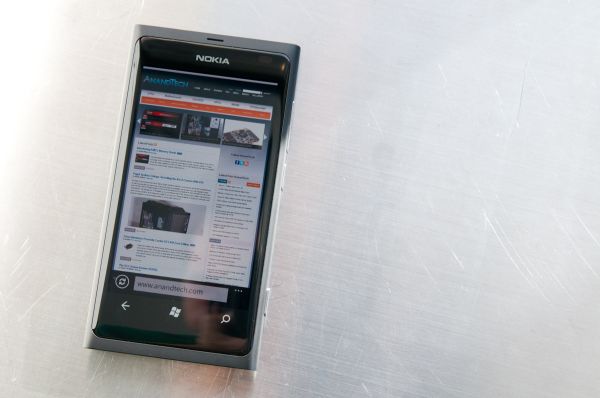
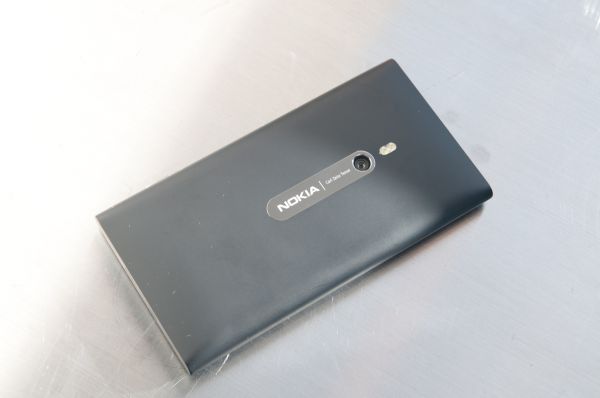
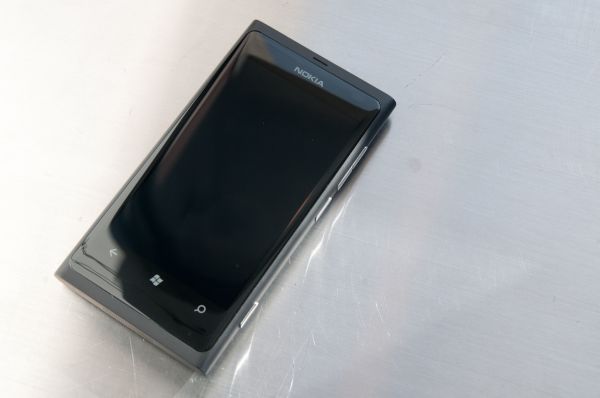
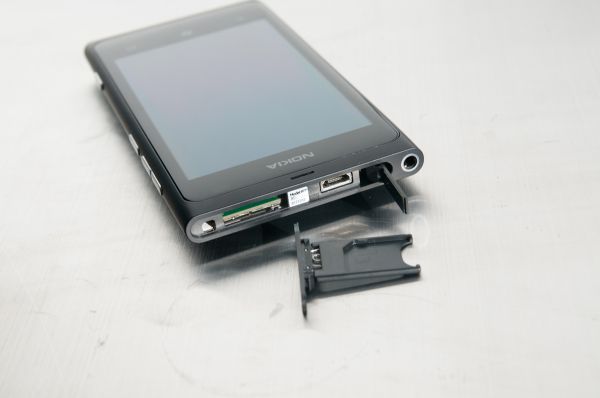
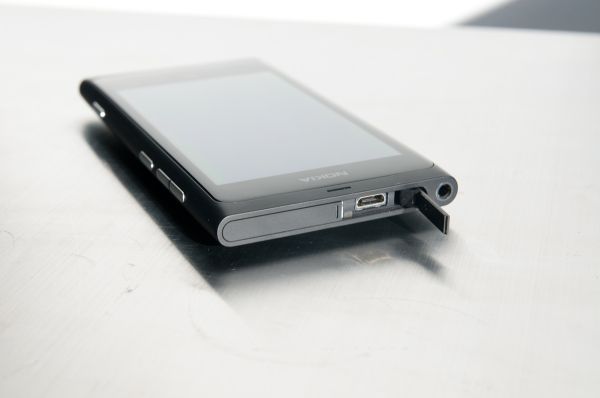
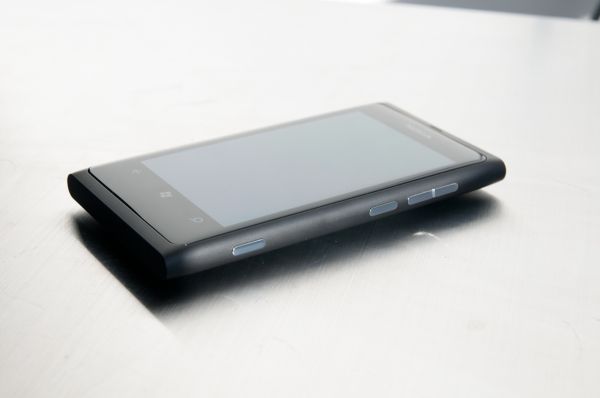

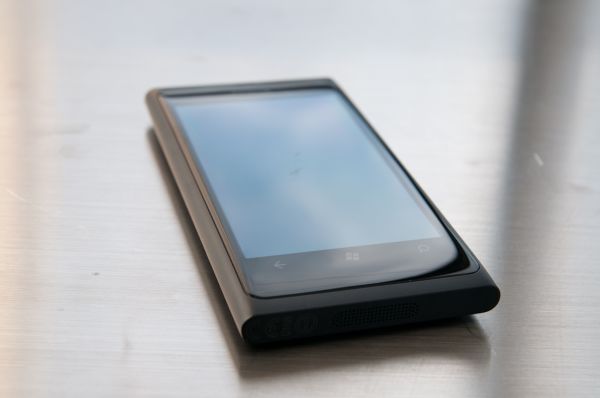






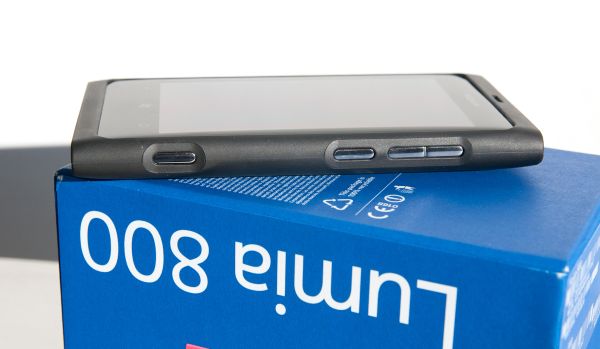








120 Comments
View All Comments
Iketh - Wednesday, January 4, 2012 - link
You can't watch youtube videos without the app on WP. If you try, the website instructs you to download the youtube app first. You can browse youtube all you want, just can't play the videos. The way the site words this almost makes it sound like it's youtube's fault, but I wouldn't know.melgross - Wednesday, January 4, 2012 - link
So, this is a fairly mediocre phone as far as performance goes, but the reviewer really wants to believe it to be better than it is.It's pretty obvious that WP7+ needs a dual core SoC, with a much better GPU. When that happens, we'll see a phone that can properly compare to the other top phones on other OS's, such as Android and iOS. Until then, no excuses can fix the slow nature of this model. If this were a cheaper, lower end model, it might be worthwhile, but for the flagship model, it's simply not worth it.
And then, AMOLED isn't really ready for prime time. Despite the propaganda from the manufacturers who use them, I've not yet seen a review of an AMOLED device that was more than about half as bright as a good LCD model, and often no better than a third as bright. This one seems poor. To say that it seems brighter than it can possibly be, is nonsense.
I hope that we will see much better phones than this one during the year, and soon. If not, it will be another reason why WP7 will struggle.
Brian Klug - Wednesday, January 4, 2012 - link
I'd agree with that assertion - WP7 does need to make the move to dual core, (and will make the move to dual core) if nothing else to get all the other features that come with it. I touched on this a little, but better encoders, better decoders, and on the QCT side better baseband all come on the high-end before eventually showing up on the midrange.The other curious thing is that AMOLED can actually go way brighter (with some of Supercurio's hacks, you can drive the SGS2 SAMOLED Plus display up past 500 nits) but you end up just burning through battery. Obviously there's still some balancing being done by OEMs to keep battery from being totally depleted.
-Brian
melgross - Wednesday, January 4, 2012 - link
There are several very good reasons why AMOLEDs aren't bright. LED's of all kinds, but especially OLED'S, are very constrained by temperature. The higher they are driven, the hotter they get. The hotter they get, the shorter the life. Driving an AMOLED screen to the brightness of the 4S, for example, would bring the lifetime down to less than a quarter of what it is now.In addition, this isn't a linear relationship. More voltage results in less than a 1:1 relationship in brightness, and an even worse relationship when looking at current draw. There's a good reason why UI's designed for AMOLED's use a great deal of black with thin lettering. On average, right now, even the best AMOLEDs use more current than do most LCDs with high efficiency LED backlighting. I find it amusing when I read that AMOLEDs use less energy, when they use more.
I have a lot of LED's here, up to 200 watts (for a single LED). I've yet to find one that lives up to its promise, though they're getting better. I would give AMOLED's at least another two years, and with IGZO displays coming out, possibly another four years until they equal the efficiency.
Color quality, which is poor, is another question altogether.
french toast - Thursday, January 5, 2012 - link
AMOLEDs typically dont come half as bright as the brightest lcds, hell the nokia 701 gets over 1000nits brightness!! so thats 5 times brighter than this model.However brightness tests like this rarely carry through to real life,especially when talking about AMOLEDS, they have the best contrast ratio as well as saturated colours which make the screen pop, you never read a review about an AMOLED phone and get complaints about it being dull..quite the contrary the AMOLED always seems to be brighter..
If brian hadnt ran that test, he wouldnt have mentioned that the screen seems dull.
Some of the appeal of AMOLEDS is that over saturated colour profile, which seems to be a marmite issue, half the people prefer IPS LCD and half swear by a decent RGB AMOLED.
AMOLEDS have many advantages over LCD though, they are thinner, much much better contrast, far far superior response time, more eye popping colours and better power levels when watching dark seens like movies...The sunlight issue which was the worse complaint has disapeared.
One of the biggest complaints about AMOLED compared to a high quality LCD is color accuracy..BUT although this is a bug for some,
most people PREFER the saturated colors, indeed when i read reviews on you tube of people comparing the most accurate hd phone display yet..the IH-IPS display on the LG Nitro the reviewers said they much prefered the nexus display, and that somehow it gave the impression of being BRIGHTER..despite what these tests say.
Spivonious - Wednesday, January 4, 2012 - link
Slow nature of this model? I have one of the launch WP7 phones (LG Quantum), and experience no slowness. The fact is that MS has optimized the OS to perform on a single-core CPU. The phone OEMs are free to add an improved GPU, but there's no need for it. Javascript benchmarks are meaningless to me. Who browses the web for any amount of time on a 4" screen?melgross - Wednesday, January 4, 2012 - link
Just read the tests. It's all there. Sometimes something doesn't feel as slow, or as fast as it is, but the numbers don't lie.465thGTG - Wednesday, January 4, 2012 - link
I'll take real world feel over benchmark numbers any day. My Titan feels faster and more fluid than my Galaxy S II. What else is there to say?doubledeej - Thursday, January 5, 2012 - link
If someone spent all day every day running Javascript, I might agree with you. But so little of the time spent using the phone is spent doing that. Everything else about the phone feels much faster than ANY Android model, regardless of CPU speed or number of cores. Having everything be GPU accelerated makes a world of difference in how fast it feels.You just never wait for anything other than your data connection on these phones.
doobydoo - Saturday, January 7, 2012 - link
I've never tried the Titan, but your reasoning is exactly why the iPhone 4S feels faster than the Galaxy S2 too - the GPU hardware acceleration.That and the fact it has the fastest CPU/GPU combination of any phone ever made.